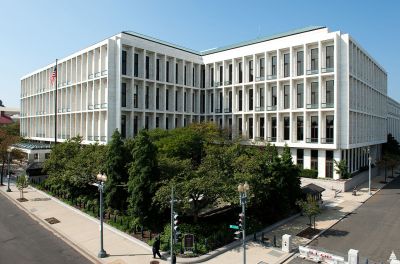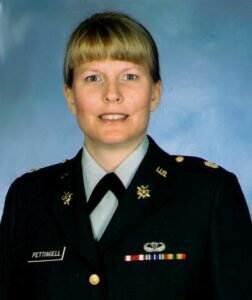I was tense. The longer we cooled our heels in the antechamber of the Hart Senate Office Building, the more time we had to wonder what awaited us behind that closed door. It was May 16, 1990–a Wednesday –and we were on hold while our boss, Colonel William “Bill” Johnson, briefed the powerful men on the other side of the door.
Barely two hours before, I had slid behind the wheel of our government sedan and driven the four of us from our office on Fort George G. Meade down to Washington, DC to rendezvous with Col. Johnson. In the car with me were my colleagues Angela Dellafiora (now Ford), Gabrielle Pettingell, and Fern Gauvin, our branch chief and direct supervisor. What Johnson was discussing, and what we ourselves had been called there to do, might well decide the ultimate fate of remote viewing in the United States military. Not only were we unsure what to expect, but the stakes of this particular meeting were immeasurably high. We had a right to be nervous.

Starting in early 1990, Sun Streak (as the remote viewing program was then officially known) had temporarily been taken away from the Defense Intelligence Agency which had “owned” remote viewing and those who did it since early 1986. The Army’s top intelligence staff in the Pentagon was now in charge, a special status meant to last for about a year.
The general who chaired the Military Intelligence Board, a decision-making body at the highest level of the Department of Defense’s spying apparatus, had ordered Johnson to take control of Sun Streak. Johnson’s assignment? To prove once and for all whether remote viewing was worth continuing as a program. This meant the colonel had two things to accomplish: Prove remote viewing could work in a carefully controlled operations setting; and “sell” it as a tool to whomever in the echelons of power was willing to listen.
We were nearly half-way through the first part of that mission. During the preceding five months our primary remote viewing task was supporting joint counter-narcotics task forces (JTF) in fighting the War on Drugs on both coasts. We were succeeding in giving our military and federal agency customers unique intelligence from remote viewing that solved some of their cases. In a testimonial from someone aware of JTF operations, “Suspects were apprehended and contraband recovered based on Star Gate’s remote viewing data.”
But now here we were, sitting almost at the threshold of “The Bubble,” the secure room in the Hart Building where the Senate Select Committee on Intelligence held classified hearings and received sensitive briefings. We were about to take a major step in the second part of Johnson’s mission: “Sell” remote viewing to very important people. And that’s how I got to meet and brief John Glenn.
Col. Johnson’s outreach efforts hit pay dirt a few weeks earlier when he caught the interest of four senior senators: William Cohen (R-ME), Daniel Inouye (D-HI), Warren Rudman (R-NH)–and John Glenn, the Democratic senator from Ohio. Working with senate staffers, Johnson was able to arrange an audience with the senators. It helped that Senator Cohen was already interested in the remote viewing program, and that he and the colonel had already made a trip together out to California where the research arm of the remote viewing program was carrying on advanced experiments.

We had been scheduled for an hour or so of the senators’ time, and Johnson had now been in with them for almost that long already. We had no idea whether that was a good or a bad sign. And then the door to “The Bubble’ swung wide and Johnson emerged, looking pleased, near as I could tell. He beckoned to Angela. The senators wanted a demonstration of remote viewing, and she was to be the first one.
More time passed. Johnson came out once again and invited Fern in. This left Gabi and me waiting by ourselves. Eventually, Angela and Fern came out, sober looks on their faces. It seemed that the anxiety of performing in front of the four senators had overwhelmed Angela’s remote viewing sensibilities and she had to bow out. So now it was our turn, and the pressure to succeed was even heavier.
Gabi walked through the door first, and I followed. We saw Col. Johnson standing to the side of the U-shaped dais where the four men sat. Ever the student of psychological operations, the colonel had scoped out the room the day before, and had placed himself and his briefing easel in a position where the senators would have to look slightly up at him while he was briefing them. But once he had introduced the two of us, Johnson was just an observer for this part of the presentation.
At the start, most of our interactions were with Senator Cohen. He welcomed us and explained the rules for the remote viewing demonstration we were about to do. He had written down the name of a target of real intelligence interest on a piece of paper which he had placed out of our sight, and said he would give us a target number to start the session when we were ready. He asked us to be seated at either end of a nearby table, where Gabi and I faced each other and away from the senators.
I no longer remember how and when the decision was made, but by the time we left Fort Meade it was set that Gabi would be the remote viewer, and I would act as monitor. My recollection is that Cohen requested that I explain those two roles, and I did. I then received the targeting number, which I repeated to Gabi, and she began to remote view. For what transpired, I’ll turn to the account from my 2005 book, Reading the Enemy’s Mind.
Gabi was soon describing an arid, desert landscape with a prominent factory or industrial complex as a focal point. I started to sweat. I was sure she was off, since I couldn’t imagine that a senator would want to test us with something as pedestrian as this. Gabi described vile smells, the sensation of danger, and chemicals.
I don’t remember what else she reported, but eventually Cohen said it was enough. Though it was hard to read their expressions, all four senators seemed interested by what had transpired. Senator Cohen held out the folded paper on which he had written the target and Colonel Johnson unfolded it. Written on it was “Rabta, Libya,” the name of Qaddafi’s secret chemical weapons factory. Gabi had nailed it. (P.404)

Gabrielle’s successful performance set a stir among the senators. They shifted a bit in their seats and glanced at one another. A couple cleared their throats. Senator Cohen thanked us, then Col. Johnson took the floor and opened it up for questions. I don’t recall either Inouye or Rudman saying anything beyond polite thanks. The bulk of the questioning came from Senators Cohen and Glenn. We were, of course, not allowed to write anything down, so I remember little of what was specifically asked. I do remember Glenn as being thoughtful and open-minded in the things he asked, and he seemed quite impressed with what he had seen and heard. Johnson eventually wrapped things up and shooed us out the door. It may seem anti-climactic, but I don’t even recall whether we had the opportunity to shake any of the senators’ hands. But I think not.
I later asked Col. Johnson how interested he thought the senators had really been. “Well, you know, they see a lot.” he said. “By the mere fact that they stayed four hours [when they had allotted less than half of that time], that tells you they were interested.”
We were quickly back to work remote viewing in support of the JTFs and other agencies, both from our military home at Fort Meade and on location in places such as Key West, Long Beach, and Alameda. Unexpectedly, I was abruptly gone from the remote viewing unit three months later, when I was given four days to report to the 101st Airborne (Air Assault) Division for deployment to Desert Shield/Desert Storm. But I kept in touch, and learned that those two senators who had been most vocal in our briefing, Cohen and Glenn, had become firm supporters of what was now known as the Star Gate remote viewing program. John Glenn had requested and received an update briefing on Star Gate’s status, and had even inquired if I were still around. Apparently I had made more of an impression than I had thought.
When some of the program’s enemies tried to close it down, those senators, along with Senator Claiborne Pell from Rhode Island, added their leverage to keep it going. Indeed, I was later to come across an official letter sent to the general who at the time was director of the Defense Intelligence Agency, and no friend of remote viewing. The letter, signed by the head of the Intelligence Community Staff stated that certain senators were not at all pleased with his attempts to undermine the remote viewing program and that the general would do well to think better of it. One of these concerned senators must certainly have been John Glenn.
We all naturally think of Glenn, whose funeral was held yesterday, as an astronaut and a senator. And, of course, he was. But almost no one is aware that he played this important, if unsung behind-the-scenes role in the government’s remote viewing psychic espionage program. At least partially due to his influence, the star Gate program was able to continue in service for five more years until it was finally ended in June of 1995, outlasting the Cold War that had given it birth.
On a final note, John Glenn also had a tie-in with UFOs, but not in the way you might think. He made an appearance on a classic episode of “Frasier” from March 6, 2001. My wife and I had just watched this a few days before Glenn passed away. You would never have guessed John Glenn could be so funny.